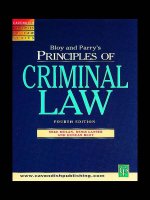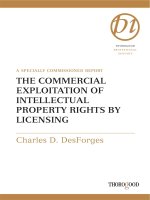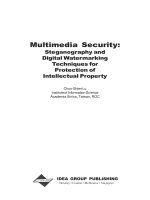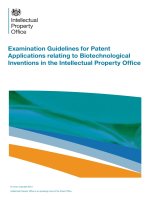- Trang chủ >>
- Cao đẳng - Đại học >>
- Luật
Intellectual Property Law Principles of Law
Bạn đang xem bản rút gọn của tài liệu. Xem và tải ngay bản đầy đủ của tài liệu tại đây (1.8 MB, 545 trang )
Principles of
Intellectual
Property
Law
CP
Cavendish
Publishing
Limited
London • Sydney
EDITORIAL ADVISORY BOARD
PRINCIPLES OF LAW SERIES
PROFESSOR PAUL DOBSON
Visiting Professor at Anglia Polytechnic University
PROFESSOR NIGEL GRAVELLS
Professor of English Law, Nottingham University
PROFESSOR PHILLIP KENNY
Professor and Head of the Law School, Northumbria University
PROFESSOR RICHARD KIDNER
Professor at the Law Department, University of Wales, Aberystwyth
In order to ensure that the material presented by each title maintains the
necessary balance between thoroughness in content and accessibility in
arrangement, each title in the series has been read and approved by an
independent specialist under the aegis of the Editorial Board. The Editorial
Board oversees the development of the series as a whole, ensuring a
conformity in all these vital aspects.
Principles of
Intellectual
Property
Law
Catherine Colston, LLB, LLM
Lecturer in Law
University of Buckingham
CP
Cavendish
Publishing
Limited
London • Sydney
First published in Great Britain 1999 by Cavendish Publishing Limited
The Glass House, Wharton Street, London WC1X 9PX, United Kingdom.
Telephone: +44 (0) 20 7278 8000
Facsimile: +44 (0) 20 7278 8080
e-mail:
Visit our Home Page on
© Colston, C 1999
All rights reserved. No part of this publication may be reproduced, stored in a
retrieval system, or transmitted, in any form or by any means, electronic,
mechanical, photocopying, recording, scanning or otherwise, except under the
terms of the Copyright Designs and Patents Act 1988 or under the terms of a
licence issued by the Copyright Licensing Agency, 90 Tottenham Court Road,
London W1P 9HE, UK, without the permission in writing of the publisher.
British Library Cataloguing in Publication Data
Colston, Catherine
Principles of intellectual property law (Principles of law series)
1 Intellectual property – Law and legislation – Great Britain
I Title
346.4'1'048
ISBN 1 85941 465 6
Printed and bound in Great Britain
FOR THE GGs
WITH LOVE
PREFACE
Intellectual property law is fascinating. We are all familiar with, and are users
of, intellectual property. In addition, the subject matter of intellectual property
– the application of an idea in making or selling products and services – forms
the fundament of a society’s cultural, technological, educational and economic
development. With the growth of trade and of the transfer of information on a
world wide scale, both intellectual property law and intellectual property
infringement are a global concern. Continuing rapid technological
development challenges and expands traditional boundaries of intellectual
property regimes. Digital recording technology, the internet, genetic
engineering all pose new challenges and new opportunities. In all, this is a
dynamic and developing subject which touches on a wide area of human
concern – trade, economic progress, intellectual and cultural advancement,
and the acquisition and dissemination of information, as well as the more
prosaic acquisition of goods and chattels.
The book is designed, when used in conjunction with a statute book, to
give a comprehensive and comprehensible introduction to intellectual
property law in the UK, within the international framework of conventions,
treaties and agreements which shape those domestic laws. The dual aim has
been to make the subject both understandable and enjoyable.
It was the preparation of teaching materials for the University of
Buckingham’s part time LLB course which prompted this book and I
gratefully acknowledge the University’s permission to draw on those
copyright Intellectual Property course materials.
It only remains to give further thanks where thanks are eminently due: to
my collegues for their support and encouragement, to Louise Hammond,
Librarian of the Denning Law Library at the University of Buckingham for her
help in tracing materials, to Rob Colston for his unfailing patience and, last,
but by no means least, to Elanor and Andy Mac, and Bridget and Dave for
preserving a much needed sense of proportion.
Catherine Colston
August 1999
vii
CONTENTS
Preface
Table of Cases
Table of Statutes
Table of Statutory Instruments
Table of European Legislation
Table of International Leglislation
Table of Abbreviations
vii
xxv
xlvii
liii
lv
lix
lxi
1
INTRODUCTION
1
1.1
PROTECTION FOR IDEAS
2
1.2
MEANS FOR PROTECTING IDEAS
3
1.2.1
1.2.2
1.2.3
3
3
6
1.3
SOURCES OF INTELLECTUAL PROPERTY LAW
1.3.1
1.3.2
1.3.3
1.3.4
1.4
Secrecy
Exclusive rights
Checks and balances on exclusive rights
National sources
International sources
Treaties and conventions
The territoriality of intellectual property rights
BASIC FORMAT TO INTELLECTUAL PROPERTY ISSUES
7
7
8
9
12
12
SUMMARY OF CHAPTER 1
13
2
JUSTIFICATION
15
2.1
OBJECTIONS TO EXCLUSIVE RIGHTS
15
2.1.1
2.1.2
2.1.3
16
17
18
2.2
Economic objections to monopoly power
Objections from developing countries
An alternative approach: unfair competition
JUSTIFICATIONS
20
2.2.1
2.2.2
21
21
Public justifications
Private justification
ix
Principles of Intellectual Property Law
2.3
2.4
2.5
JUSTIFICATIONS FOR PATENTS
21
2.3.1
2.3.2
2.3.3
2.3.4
2.3.5
22
22
22
26
27
A natural right
Reward by monopoly
Monopoly profit incentive
Exchange for secrets
Conclusion
JUSTIFICATIONS FOR COPYRIGHT
27
2.4.1
2.4.2
2.4.3
2.4.4
27
28
28
29
Authors’ rights and neighbouring rights
The origins of UK copyright law
Author and entrepreneur
Justifications
TRADE MARKS
30
2.5.1
2.5.2
2.5.3
31
31
32
Private justifications
Justifications in the public interest
Criticisms of trade mark protection
SUMMARY OF CHAPTER 2
35
3
THE PATENT
37
3.1
THE STRUCTURE OF PATENT LAW
37
3.2
PATENT TERMINOLOGY
38
3.3
PATENTS ACT 1977
39
3.3.1
39
3.4
3.5
Provision for convention conformity
APPLICATION FOR A PATENT
40
3.4.1
3.4.2
3.4.3
3.4.4
3.4.5
41
41
42
44
45
Routes to grant
Priority
Priority and enabling disclosures
Application for a UK patent
Specification and claims
OWNERSHIP OF THE PATENT
46
3.5.1
3.5.2
47
50
Ownership by the employer
Ownership by the employee
x
Contents
3.5.3
3.5.4
3.6
3.7
Agreements between employee and employer
concerning patent ownership
The compensation scheme
50
50
THE PROPRIETARY RIGHT
54
3.6.1
55
Duration of the patent right
PATENT LICENSES
55
3.7.1
3.7.2
3.7.3
3.7.4
56
56
57
57
Tying clauses
Compulsory licences
Licences of right
Crown use
SUMMARY OF CHAPTER 3
59
4
PATENTABLE INVENTIONS
61
4.1
INVENTIONS
61
4.1.1
4.1.2
4.1.3
4.2
Judicial dicta
The concept of invention
Valid patents for inventions
62
62
63
EXCLUDED CATEGORIES
63
4.2.1
4.2.2
4.2.3
4.2.4
4.2.5
4.2.6
4.2.7
4.2.8
4.2.9
4.2.10
4.2.11
4.2.12
64
65
69
71
72
73
73
76
77
78
79
80
The proviso to s 1(2) of the PA 1977
Computer programs
Discoveries and mathematical methods
Schemes, rules and methods
Presentations of information
Aesthetic creations
Exclusions on the ground of morality
Biological inventions
Plant varieties
Animal varieties
Essentially biological processes
Microbiological processes
xi
Principles of Intellectual Property Law
4.3
4.4
4.5
INDUSTRIAL APPLICATION
81
4.3.1
4.3.2
4.3.3
81
81
81
NOVELTY
86
4.4.1
4.4.2
4.4.3
4.4.4
4.4.5
4.4.6
86
87
87
93
93
95
4.7
The right to work
Testing novelty
The state of the art
Construing the claims
Comparing invention and prior art
New uses of a known thing
INVENTIVE STEP
4.5.1
4.5.2
4.5.3
4.5.4
4.5.5
4.6
Industry
The useless invention
The medical invention
98
Determining obviousness
The state of the art
The hypothetical technician
The relevant field
Making the comparison
99
99
100
101
102
DISCLOSURE
103
4.6.1
4.6.2
104
105
The specification
The claims
GENETIC ENGINEERING AND PATENTABILITY
106
SUMMARY OF CHAPTER 4
109
5
INFRINGEMENT, VALIDITY AND REVOCATION
115
5.1
CONSTRUCTION OF CLAIMS
5.1.2
5.1.3
5.1.4
5.1.5
115
Non-literal infringement and the ‘pith and marrow’
doctrine
Purposive construction
Article 69 of the EPC and the Protocol
A new approach?
xii
116
118
119
121
Contents
5.2
5.3
5.4
INFRINGING ACTS
122
5.2.1
5.2.2
123
126
Primary and secondary infringement
Contributory infringement
DEFENCES
126
5.3.1
5.3.2
5.3.3
5.3.4
5.3.5
126
127
127
128
128
Putting the validity of the patent in issue
Section 60(5) of the PA 1977
Prior use
Exhaustion
The ‘Gillette defence’
REVOCATION AND OPPOSITION
129
5.4.1
5.4.2
5.4.3
129
129
130
Third party observations
Revocation
EPO opposition
SUMMARY OF CHAPTER 5
131
6
BREACH OF CONFIDENCE
133
6.1
THE NATURE OF THE ACTION
133
6.2
THE CONDITIONS FOR A REMEDY
134
6.3
CONFIDENTIAL INFORMATION
135
6.3.1
6.3.2
6.3.3
135
137
144
6.4
6.5
Information
Confidentiality
Information in the public interest
THE OBLIGATION OF CONFIDENCE
147
6.4.1
6.4.2
6.4.3
148
154
156
The direct recipient
The indirect recipient
No relationship
BREACH
158
6.5.1
6.5.2
159
159
Subconscious breach
Detriment to the plaintiff
xiii
Principles of Intellectual Property Law
6.5.3
6.5.4
6.5.5
Inducing breach of contract
Defences
Remedies
SUMMARY OF CHAPTER 6
160
160
161
163
7
COPYRIGHT PRINCIPLES AND COPYRIGHT
WORKS
167
7.1
BASIC PRINCIPLES
167
7.1.1
7.1.2
7.1.3
7.1.4
7.1.5
7.1.6
7.1.7
168
169
170
173
174
174
176
A work
Fixation of a work
Originality
Reporter’s copyright
Independent creation
The idea-expression dichotomy
Overlapping copyrights
7.2
COPYRIGHT WORKS
176
7.3
ORIGINAL WORKS
177
7.3.1
7.3.2
7.3.3
7.3.4
177
178
180
180
7.4
Literary works
Dramatic works
Musical works
Artistic works
DERIVATIVE WORKS
185
7.4.1.
7.4.2
7.4.3
7.4.4
7.4.5
185
186
186
187
188
Sound recordings
Films
Broadcasts
Cable programmes
Typographical arrangements of published editions
SUMMARY OF CHAPTER 7
189
xiv
Contents
8
THE SUBSISTENCE AND SUBSTANCE OF
COPYRIGHT
193
8.1
QUALIFICATION
193
8.1.1
8.1.2
8.1.3
193
194
194
8.2
8.3
8.4
Author’s status
Place of first publication
Publication
AUTHORSHIP
196
8.2.1
8.2.2
8.2.3
8.2.4
8.2.5
8.2.6
196
197
198
198
199
200
Joint authorship
Original works
Works of artistic craftsmanship
Photographs
Computer generated works
Derivative works
OWNERSHIP OF COPYRIGHT
201
8.3.1
8.3.2
Employed authors
Commissioned works
201
203
DURATION OF COPYRIGHT
205
8.4.1
8.4.2
8.4.3
8.4.4
8.4.5
8.4.6
205
206
206
207
207
207
Lesser terms of protection
Original works
Films
The other derivative works
Revived copyright
The length of copyright
8.5
REFUSAL OF COPYRIGHT
208
8.6
THE EXCLUSIVE RIGHTS
209
8.6.1
8.6.2
8.6.3
8.6.4
8.6.5
210
210
210
211
8.6.6
Copying
Issuing copies to the public
Rental right
Performance rights
Broadcast and inclusion within a cable
programme service
Adaptation
xv
212
212
Principles of Intellectual Property Law
8.6.7
8.6.8
Publication right
Copyright in the information society
SUMMARY OF CHAPTER 8
213
213
215
9
INFRINGEMENT OF COPYRIGHT AND
PERMITTED ACTS
219
9.1
INFRINGEMENT
219
9.2
PRIMARY INFRINGEMENT
219
9.2.1
9.2.2
9.2.3
9.2.4
9.2.5
219
225
225
228
230
9.3
9.4
9.5
9.6
Copying
Direct and indirect infringement
Substantial part
Authorising infringement
Infringement of secondary works
SECONDARY INFRINGEMENT
230
9.3.1
9.3.2
231
232
Reasonable knowledge
Infringing copy
DEFENCES
233
9.4.1
9.4.2
9.4.3
233
234
236
Implied licences
Spare parts
Public interest
FAIR DEALING
237
9.5.1
9.5.2
9.5.3
9.5.4
9.5.5
9.5.6
238
238
240
241
241
243
Dealing
Fair
‘For the purpose of ...’
Research or private study
Criticism or review
Reporting current events
THE PERMITTED ACTS
243
9.6.1
9.6.2
244
244
Piracy
Home copying
xvi
Contents
9.6.3
9.6.4
9.6.5
News and media
Educational copying and libraries
Other
246
247
248
9.7
COPYRIGHT ASSIGNMENT AND LICENSING
249
9.8
COLLECTIVE LICENSING AND THE COPYRIGHT
TRIBUNAL
249
9.8.1
9.8.2
9.8.3
251
251
251
Competition policy
Compulsory licences
The Copyright Tribunal
SUMMARY OF CHAPTER 9
253
10 MORAL RIGHTS
257
10.1 THE BACKGROUND
257
10.2 THE UK BEFORE THE CDPA 1988
259
10.2.1
10.2.2
10.2.3
10.2.4
Contract
Defamation
Passing off, injurious falsehood and
breach of confidence
Copyright Act 1956
10.3 THE CDPA 1988
10.3.1
10.3.2
10.3.3
The four moral rights
Remedies for breach of moral rights
The duration of moral rights
262
263
263
263
The need to assert the right of paternity
Exceptions to the right of paternity
10.5 RIGHT OF INTEGRITY
10.5.1
10.5.2
10.5.3
260
261
262
10.4 THE RIGHT OF PATERNITY
10.4.1
10.4.2
259
260
264
265
266
‘Derogatory treatment’
Exceptions to the right of integrity
Remedies for breach of the right of integrity
xvii
267
268
269
Principles of Intellectual Property Law
10.6 THE RIGHT AGAINST FALSE ATTRIBUTION
269
10.7 THE RIGHT TO PRIVACY
270
10.8 WAIVER OF RIGHTS
271
10.9 COMMENTARY
272
SUMMARY OF CHAPTER 10
275
11 DESIGN RIGHTS
279
11.1 THE DESIGN FIELD
279
11.1.1
11.1.2
Characteristics of design rights
Design protection before the Copyright, Designs and
Patents Act 1988
11.2 ARTISTIC COPYRIGHT
11.2.1
11.2.2
11.2.3
11.2.4
Section 51 of the Copyright, Designs
and Patents Act 1988
The interpretation of s 51 of the Copyright, Designs
and Patents Act 1988
Non-derogation from grant
Section 52 of the Copyright, Designs
and Patents Act 1988
282
282
283
283
284
Article
Design
Excluded features
Eye appeal
Material appearance
Novelty
Infringement
285
286
286
288
289
290
291
11.4 UNREGISTERED DESIGN RIGHT
11.4.1
11.4.2
11.4.3
11.4.4
11.4.5
280
281
11.3 REGISTERED DESIGN
11.3.1
11.3.2
11.3.3
11.3.4
11.3.5
11.3.6
11.3.7
279
Design
Exceptions
Original
Infringement
Remedies
292
294
295
297
298
300
xviii
Contents
11.5 OVERLAP OF RIGHTS
300
11.6 THE FUTURE
301
SUMMARY OF CHAPTER 11
303
12 PASSING OFF
309
12.1 THE DEVELOPMENT AND DEFINITION OF PASSING OFF
310
12.1.1
12.1.2
The elements of the passing off action
Developments in passing off
12.2 REPUTATION
12.2.1
12.2.2
12.2.3
12.2.4
12.2.5
313
Shared reputation
Goodwill
The coincidence of reputation and goodwill
in point of time
Geographical coincidence of reputation
and goodwill
Coincidence of activity of plaintiff
and defendant
12.3 MISREPRESENTATION
12.3.1
12.3.2
12.3.3
12.3.4
12.3.5
310
311
314
314
315
316
319
321
Indicia of reputation
The nature of misrepresentation
The test of misrepresentation
Evidence of confusion
Reverse passing off
321
324
325
328
330
12.4 DAMAGE
330
12.4.1
12.4.2
331
334
Dilution
Passing off and domain names
12.5 CHARACTER MERCHANDISING
12.5.1
Passing off and character merchandising
335
335
12.6 LOOKALIKE PRODUCTS
337
SUMMARY OF CHAPTER 12
339
xix
Principles of Intellectual Property Law
13 REGISTERED TRADE MARKS
343
13.1 INTRODUCTION
343
13.1.1
13.1.2
13.1.3
The new law
The nature of a trade mark
The functions of a trade mark
13.2 REGISTRATION OF A MARK
13.2.1
13.2.2
13.2.3
13.2.4
347
National application
International protection
The Community trade mark
Registrability of a mark
13.3 THE DEFINITION OF A TRADE MARK
13.3.1
13.3.2
13.3.3
13.3.4
13.3.5
A sign
Colour
Shapes
Capable of distinguishing
Retail services
13.4 THE ABSOLUTE GROUNDS OF REFUSAL
13.4.1
13.4.2
13.4.3
13.4.4
13.4.5
13.4.6
13.4.7
13.4.8
13.4.9
13.4.10
Not a trade mark
Non-distinctive signs
The proviso to s 3(1)(b)–(d) of the TMA 1994
Descriptive marks
Customary marks
Objectionable and deceptive marks
Prohibited marks
Specially protected emblems
Applications made in bad faith
Shapes
13.5 THE RELATIVE GROUNDS OF REFUSAL
13.5.1
13.5.2
13.5.3
13.5.4
343
345
346
Earlier marks
Earlier rights
Interpretation
The comparison
348
349
350
350
350
352
353
353
354
356
357
357
357
358
360
361
361
363
363
363
365
368
368
369
369
369
xx
Contents
13.5.5
13.5.6
Raising the relative grounds of refusal
Honest concurrent user
370
371
SUMMARY OF CHAPTER 13
373
14 TRADE MARK INFRINGEMENT AND
CHALLENGES TO TRADE MARKS
379
14.1 THE EXCLUSIVE RIGHT
379
14.2 INFRINGEMENT
380
14.2.1
14.2.2
14.2.3
14.2.4
Identical marks/identical goods or services
Identical marks/similar goods or services;
similar marks/identical or similar goods
or services
Identical or similar marks/dissimilar goods
or services
Comparative Advertising
14.3 WELL KNOWN MARKS
14.3.1
14.3.2
383
383
388
390
393
Injunctions against the use of well known marks
‘Well known’
393
394
14.4 DEFENCES
396
14.5 REVOCATION, INVALIDITY AND ACQUIESCENCE
397
14.5.1
14.5.2
14.5.3
Revocation
Invalidity
Acquiescence
397
399
399
14.6 PROPERTY AND DEALINGS IN MARKS
400
14.7 THREATS
402
SUMMARY OF CHAPTER 14
403
15 REMEDIES
409
15.1 PROCEEDINGS
410
15.1.1
15.1.2
Criminal proceedings
Administrative action
410
410
xxi
Principles of Intellectual Property Law
15.1.3
15.1.4
Self-help
Civil proceedings
411
411
15.2 ACCOUNT OF PROFITS
411
15.3 DELIVERY UP
412
15.4 DAMAGES
412
15.4.1
15.4.2
15.4.3
412
413
415
Measure of damages
Parasitic and bridgehead damages
Innocent defendants
15.5 INJUNCTIONS
15.5.1
415
Interlocutory injunctions
15.6 ANTON PILLER ORDERS
15.6.1
15.6.2
15.6.3
15.6.4
419
Conditions for grant
The potential for abuse
New safeguards
Self-incrimination
419
420
421
422
15.7 MAREVA INJUNCTIONS
15.7.1
422
Conditions for grant
423
15.8 THREATS OF PROCEEDINGS
15.8.1
15.8.2
416
423
Defences to threats action
Section 70(4) of the Patents Act 1977
424
424
SUMMARY OF CHAPTER 15
425
16 INTELLECTUAL PROPERTY AND THE
EUROPEAN UNION
429
16.1 INTELLECTUAL PROPERTY RIGHTS IN THE
EUROPEAN UNION
429
16.1.1
16.1.2
Harmonisation directives
Regulations
16.2 FREE MOVEMENT OF GOODS
16.2.1
16.2.2
Principles applied by the European Court of Justice
The existence/exercise distinction
xxii
430
431
431
432
433
Contents
16.2.3
16.2.4
The subject matter of rights
The concept of exhaustion
16.3 COMPETITION POLICY
16.3.1
16.3.2
16.3.3
433
434
435
Intellectual property agreements
Article 81 of the EC Treaty
Article 82 of the EC Treaty
436
436
437
16.4 OTHER IMPACTS OF EU LAW ON NATIONAL
INTELLECTUAL PROPERTY LAWS
439
SUMMARY OF CHAPTER 16
441
FURTHER READING
443
Index
455
xxiii









